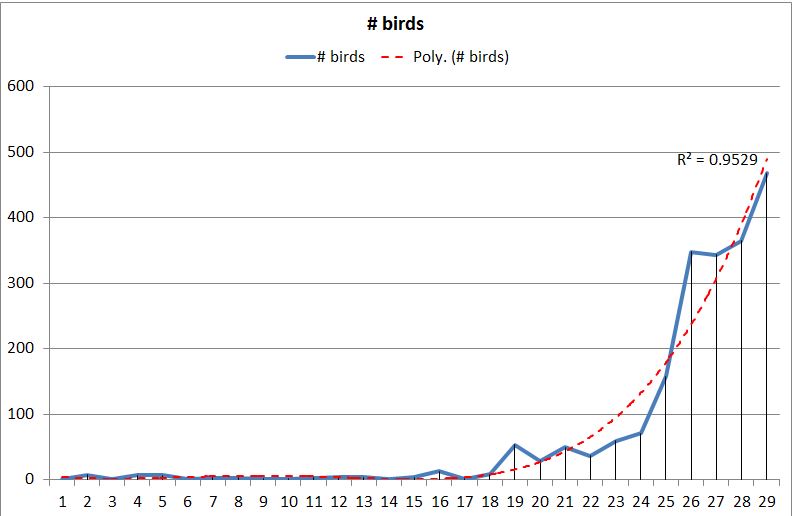 |
canberrabirds
|
 |
canberrabirds
|
| To: | COG List <> |
|---|---|
| Subject: | Fwd: [canberrabirds] Grey Butcherbird |
| From: | Martin Butterfield <> |
| Date: | Fri, 30 Aug 2019 05:45:05 +0000 |
|
See below: I meant to reply to all but by accident only sent to Geoffrey originally.
Martin Butterfield
---------- Forwarded message ---------
From: Martin Butterfield <> Date: Fri, 30 Aug 2019 at 10:33 Subject: Grey Butcherbird To: Geoffrey Dabb <> I have looked at the first 30 years of the GBS data on Grey Butcherbirds and charted the total number of birds reported. (I suspect that using A values would give a similar pattern so haven't done the extra
calculations.)
 The major growth appears in
year 24, after the 2003 fires leading to a view that they may have driven the Butcherbirds out of the Brindabellas. To sort-of test that I then charted up to year 24 and projected the trend forward 6 years. That gives a projected number of Grey Butcherbirds
in year 30 of about 120, rather than the 468 actually reported. I think this discrepancy is more than could be explained by simple demographics so it tends to support the idea of an infusion of birds from the fireground. Having got to the urban area they
found it to their liking, as well meaning retirees flick mince for them!
Martin Butterfield
On Fri, 30 Aug 2019 at 08:43, Geoffrey Dabb <> wrote:
Attachment:
|
| <Prev in Thread] | Current Thread | [Next in Thread> |
|---|---|---|
| ||
| Previous by Date: | Feral Pigeons, Con Boekel |
|---|---|
| Next by Date: | Feral Pigeons, Alan Ford |
| Previous by Thread: | FW: [canberrabirds] Grey Butcherbird, Geoffrey Dabb |
| Next by Thread: | Oriole, Anthony Overs |
| Indexes: | [Date] [Thread] [Top] [All Lists] |
The University of NSW School of Computer and Engineering takes no responsibility for the contents of this archive. It is purely a compilation of material sent by many people to the Canberra Ornithologists Group mailing list. It has not been checked for accuracy nor its content verified in any way. If you wish to get material removed from the archive or have other queries about the list contact David McDonald, list manager, phone (02) 6231 8904 or email . If you can not contact David McDonald e-mail Andrew Taylor at this address: andrewt@cse.unsw.EDU.AU